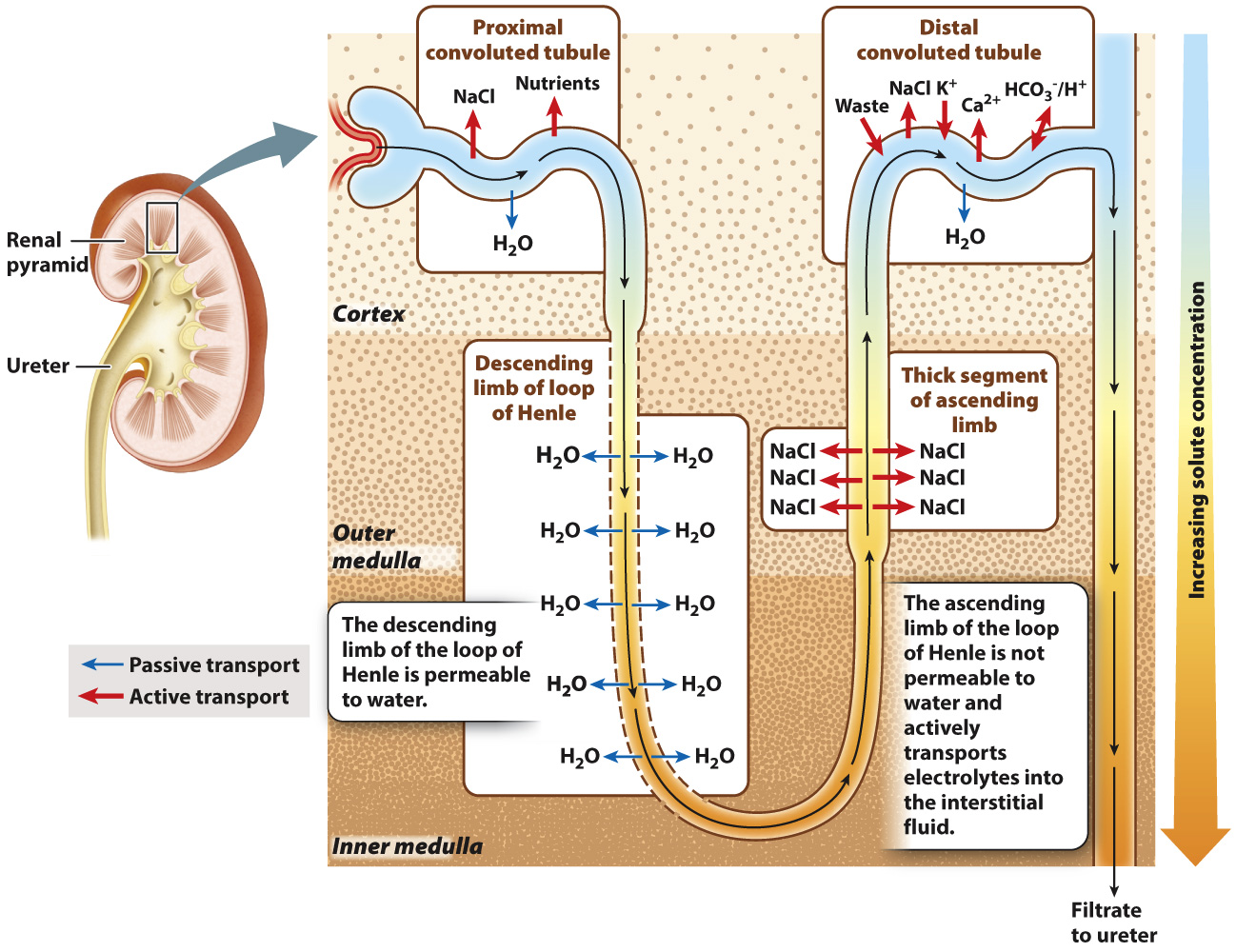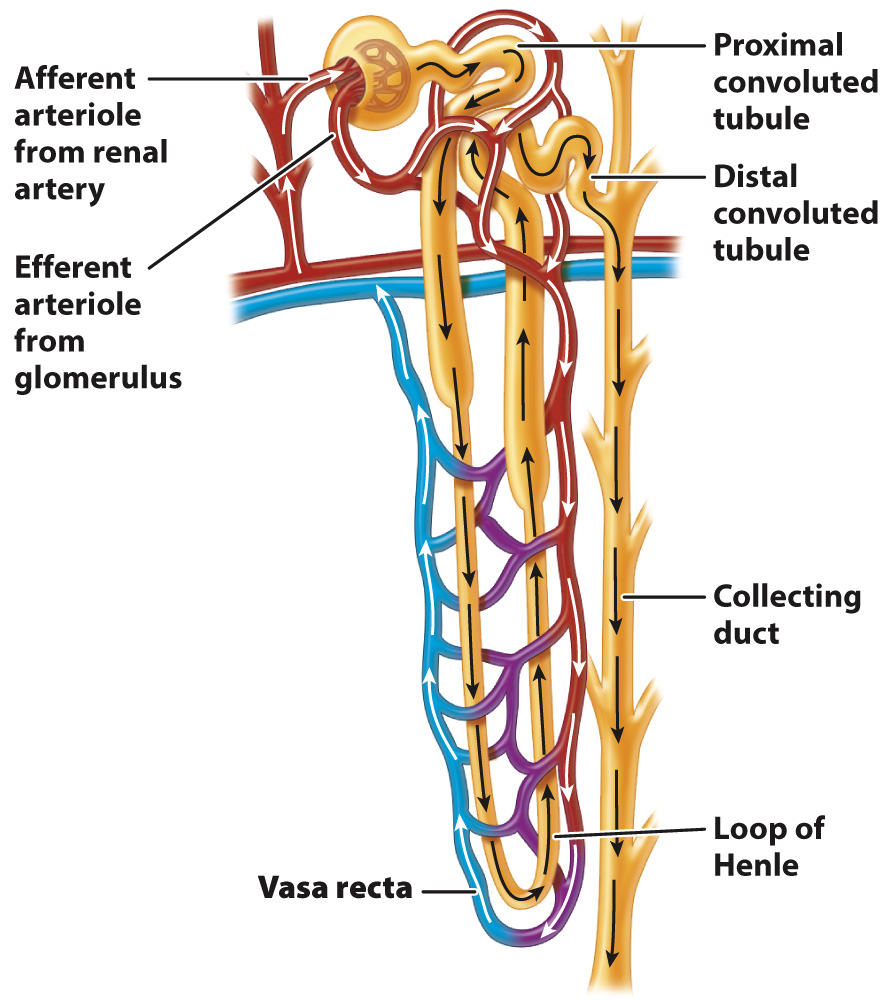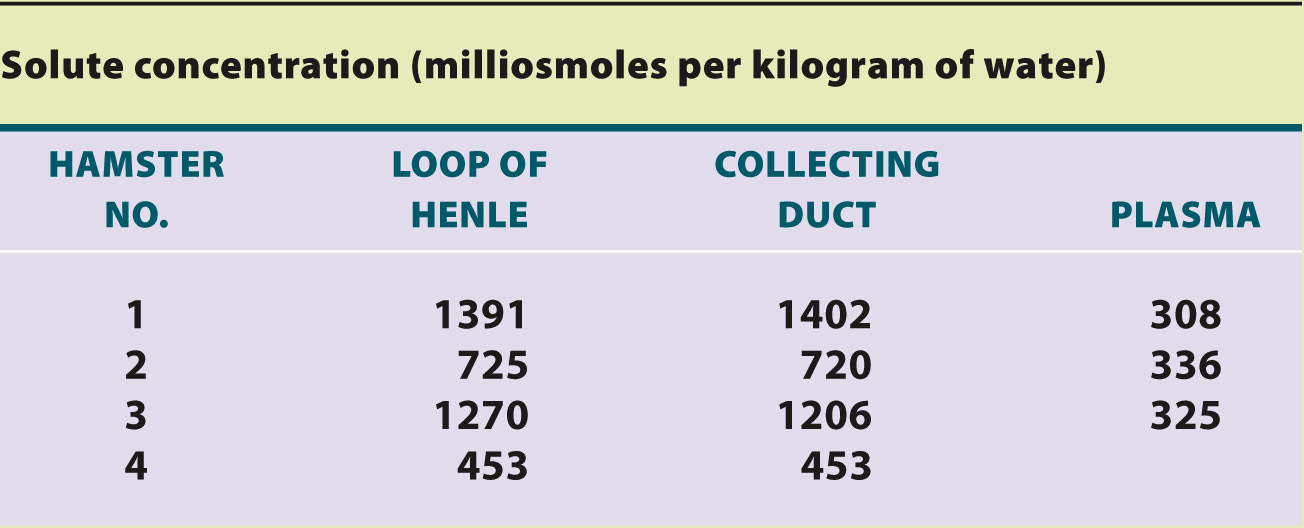The loop of Henle acts as a countercurrent multiplier to create a concentration gradient from the cortex to the medulla.
The proximal convoluted tubule connects to the loop of Henle, the second portion of the renal tubule (Fig. 41.17). Although many nephrons contain short loops of Henle that are confined to the renal cortex, some descend all the way into the medulla before looping back up to the cortex. These longer loops of Henle play an important role: They create a concentration gradient in the interstitial fluid from the cortex to the medulla, so the interstitial fluid of the cortex is less concentrated in solutes and the interstitial fluid of the medulla is more concentrated in solutes. This concentration gradient allows water passing through the downstream collecting duct to be reabsorbed by osmosis, producing concentrated urine.
How is the gradient generated? The key to understanding how the loop of Henle creates a concentration gradient is to recognize that the two limbs of the loop of Henle run in parallel but opposite directions, and they differ in their permeability to water and ability to actively transport electrolytes out of the tubule. Although the filtrate enters the descending limb before looping around to the ascending limb, it is easier to consider the ascending limb first.
The thick portion of the ascending limb of the loop of Henle is impermeable to water but not electrolytes (Fig. 41.18). As the filtrate moves up the thick ascending limb of the loop of Henle, electrolytes are actively transported out of it into the surrounding interstitial fluid. As a result, the interstitial fluid becomes more concentrated, and the filtrate passing through the ascending limb becomes less concentrated.

889
In contrast to the ascending limb, the descending limb is permeable to water. Therefore, water moves passively out of the descending limb, driven by osmosis due to the electrolytes pumped into the interstitial fluid by the ascending limb. As water moves out of the descending limb, the filtrate becomes more and more concentrated, matching the concentration in the surrounding interstitial space. We have already seen that, as electrolytes are pumped out of the thick ascending limb, the filtrate becomes less and less concentrated. Thus, the filtrate enters and leaves the loop of Henle at about the same concentration. Although filtrate concentration is unchanged, the trip around the loop creates a concentration gradient in the interstitial fluid surrounding the loop of Henle, with fluid in the inner medulla much more concentrated than that in the outer cortex.
The gradient results from the combination of active transport of electrolytes in the ascending limb, osmosis of water in the descending limb, and the movement of the filtrate through the loop of Henle. The filtrate is most concentrated at the base of the loop, and the concentration of solutes inside and outside the loop is about the same, leaving the medulla more concentrated than the cortex.

In Chapter 39, we saw how the movement of water and blood in opposite directions in fish gills provides an efficient way to extract oxygen from the water and move it into the blood. This mechanism, called countercurrent exchange, is an efficient mechanism by which two fluids can exchange properties such as amounts of oxygen. In the loop of Henle, active transport of electrolytes creates a concentration gradient, which is then multiplied because the descending and ascending limbs move in parallel but opposite directions. This system is therefore known as a countercurrent multiplier. While countercurrent exchangers maintain a concentration gradient, countercurrent multipliers generate them.
890
There is one more important point to consider. Typically, a high concentration of solutes in the interstitial fluid would be quickly lost because of water flowing out of blood vessels by osmosis. To avoid dissipating the concentration gradient, the blood vessels in the kidneys are arranged in a particular fashion. The blood vessels, collectively called the vasa recta, have descending and ascending vessels arranged in a countercurrent organization, just like the loops of Henle (Fig. 41.19). The blood within these vessels flows down into the medulla in one arm and back up through the cortex in the other. This arrangement maintains the concentration gradient. Blood flowing from the cortex to the base of the kidney encounters increasingly concentrated interstitial fluid, allowing the passive diffusion of water out of the blood. However, the descending vessels pass in proximity to ascending vessels, which reabsorb the water. In effect, water passes straight from one arm of the vasa recta to the other, so the interstitial fluid and the bloodstream have no net gain or loss of water.
The generation of a concentration gradient by a countercurrent multiplier in the loop of Henle is a key step in the production of urine that is more concentrated than the blood. It was first proposed by the Swiss chemist Werner Kuhn in the 1950s. Although his hypothesis was initially met with skepticism, subsequent experimental work confirmed its predictions (Fig. 41.20).
HOW DO WE KNOW?
FIG. 41.20
How does the mammalian kidney produce concentrated urine?
BACKGROUND The mammalian kidney produces urine that is more concentrated than the blood. How it concentrates urine was one of the most perplexing problems in renal physiology.
HYPOTHESIS One hypothesis is that the kidney actively transports water out of the collecting ducts as the filtrate leaves the kidney. Another, first suggested by the Swiss chemist Werner Kuhn in the early 1950s, is that the loop of Henle creates a concentration gradient from the cortex to the medulla by a countercurrent multiplier mechanism. According to this model, the solute concentration is low in the cortex and high in the medulla, so water leaves the collecting ducts passively as it moves from the cortex to the medulla.
PREDICTION A prediction of Kuhn’s hypothesis is that the solute concentrations of fluid taken at the same level from the medulla, loop of Henle, and collecting ducts should be similar to one another, and higher than that of the blood. If, instead, water is simply pumped out of the collecting ducts, then the fluid in the collecting ducts should be more concentrated than that in the loop of Henle.
EXPERIMENT American physiologists Carl W. Gottschalk and Margaret Mylle tested Kuhn’s hypothesis. They used innovative micropuncture techniques in hamsters to measure the solute concentration of fluid taken from the bend of the loop of Henle and the collecting ducts at the same level.

RESULTS Their results, shown in the table, are consistent with the predictions of Kuhn’s hypothesis. That is, the solute concentrations of the fluid in the loop of Henle and in the collecting ducts are similar to each other and higher than that of the blood.
CONCLUSION These results are consistent with a model in which concentrated urine is produced by first generating a concentration gradient between the cortex and the medulla, and then allowing water to move out of the collecting ducts by osmosis.
FOLLOW-
SOURCES Gottschalk, C. W., and M. Mylle. 1958. “Evidence That the Mammalian Nephron Functions as a Countercurrent Multiplier System.” Science 128:594; Gottschalk, C. W., and M. Mylle. 1959. “Micropuncture Study of the Mammalian Urinary Concentrating Mechanism: Evidence for the Countercurrent Hypothesis.” American Journal of Physiology 196 (4):927–
891
Quick Check 4 The filtrate is dilute at the start and end of the loop of Henle. What, then, is the function of the loop of Henle?
Quick Check 4 Answer
Although the filtrate is dilute at the start and end of the loop of Henle, the loop creates a concentration gradient from the cortex to the medulla, which is important for subsequent water reabsorption from the collecting ducts. The loops also leave urea as the main solute.